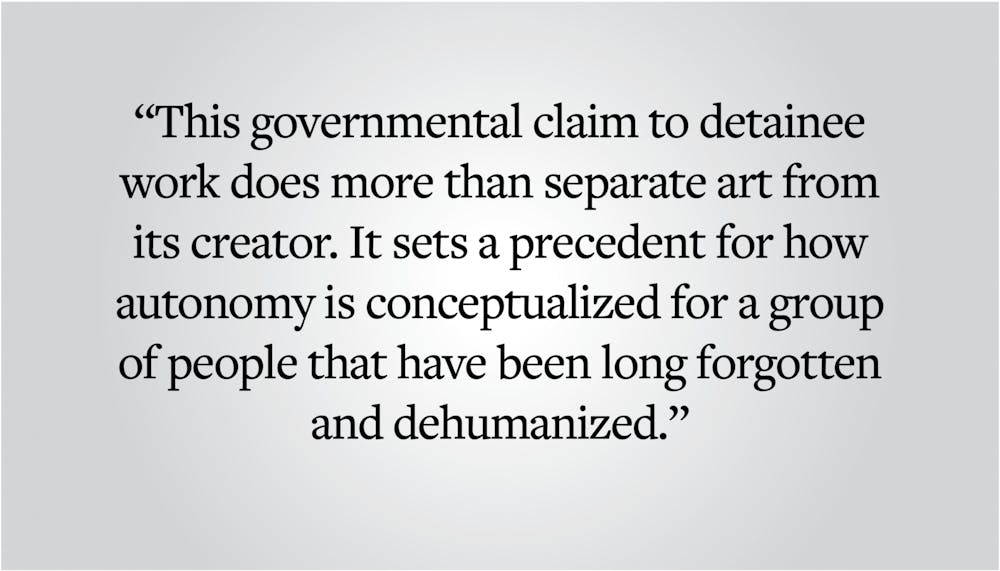Dental floss, prayer beads, and razors. These are the mediums Moath al-Alwi uses to create art at the Guantanamo Bay Naval Base, where he has been detained since 2002. Al-Alwi uses anything and everything — from old t-shirts to sponges — to carefully craft models of ships and gondolas. At times, he is so engrossed in an artistic vision that he goes days without sleeping to bring his ideas to life.
Art can be found in many corners of Guantanamo Bay, where detainees articulate their experiences through a variety of poignant visual representations. But when art is born within the confines of a naval base that operates outside the realm of law, it does not belong to its creator. It belongs to the United States. While policy surrounding the ownership of this art is changing slowly, incarcerated artists are still separated in practice from most of the work that they do — significant work remains to return it to their rightful owners.
Until a policy reversal in February, even once detainees were freed, a Trump-era policy ensured that their art remained behind bars.
This directly affected detainees like al-Alwi, a citizen of Yemen, who was captured in Afghanistan by Pakistani bounty hunters and turned over to American custody in 2002. He is among hundreds of men who were suspected of al-Qaeda involvement amid the U.S.’s draconian post-9/11 counterterrorism crackdown. Al-Alwi is one of Gitmo’s ‘forever prisoners’ — men who were never charged with a crime and have been indefinitely detained despite being cleared for transfer. While promises made in 2010 by the Obama administration to close Guantanamo Bay never came true, these detainees have since been able to negotiate for small strides toward better living conditions. One such step has been increased access to art classes, which gave new meaning to life within the prison.
An exhibition of art made in Guantanamo Bay called “Ode to the Sea” renewed international media coverage on the U.S.’s human rights abuses. This exhibition was inspired by a brief moment in 2014 that allowed the detainees to see the sea for the first time since being detained; the threat of a hurricane forced the guards to take down tarps from the windows. “In Our Prison on the Sea,” an op-ed written by former detainee Mansoor Adayfi in 2017, describes this moment as the creation of an artistic movement in the prison: “Some wrote poems about it. And everyone who could draw drew the sea. I could see different meanings in each drawing, color and shape.”
Unsurprisingly, the Department of Defense suspended the transfer of art from the naval base soon after. In 2017, they released a statement citing national security concerns about where proceeds from the art went and indicating the possibility of confiscating the artwork, while some reports claimed that officials had even threatened to destroy it. It was the first time the United States government explicitly claimed the art as their property.
Lawyers representing Guantanamo’s detainees began having difficulty processing their clients’ art for release. An implicit ban against art leaving the base was enforced, and when pieces did leave, they had to undergo intense security checks.
Earlier this year, the Department of Defense finally lifted this ban, but the results haven’t been too promising — in a statement, the Department writes that just “a practicable quantity of their art” can now be taken by detainees when they leave the base, and that the art still belongs to the government. An air of evasiveness remains: Lt. Col. Cesar H. Santiago, the Pentagon spokesman who released the recent statement, has refused to say when the new policy will be enacted or how much art is a “practicable amount.” The material impacts of this policy reversal remain uncertain.
This governmental claim to detainee work does more than separate art from its creator. It sets a precedent for how autonomy is conceptualized for a group of people that have been long forgotten and dehumanized. One detainee, Khalid Qasim, stated that he had no interest in leaving Guantanamo without his art, explaining how freedom is not attained if a part of them remains imprisoned. Even without this unnecessary injustice, repatriated detainees already face intense difficulties rehabilitating after being released. With a 20-year absence from the outside world and no passport, former detainees are often considered stateless and in limbo. This art is not only emblematic of courage retained at a time of hopelessness, but this art is all detainees have to their name upon reentering the world — especially for detainees like Sabri al-Qurashi, an artist looking to collaborate with curators all across the world after leaving Guantanamo Bay. Guantanamo-made artwork has even been sensationalized by celebrities — Ben Affleck owns a $550 piece his mom purchased for him as a Christmas gift. Detainees should have the ability to sell their artwork themselves at its true value.
This trudge toward reform is happening at an optimal time. 20 of the 31 remaining detainees at Guantanamo are cleared for transfer, now awaiting resettlement: To this day, the majority of them have not been charged with a crime. The Biden Administration has slowly reignited efforts to transfer prisoners: Most recently, Majid Khan was resettled to Belize and he brought 46 pages of poems with him — all of which underwent intense security screening before being released.
Al-Alwi’s intricate ships, which were luckily released before the Trump-era ban, are on display through Art from Guantánamo Bay, an organization that curates and supports this work. Just like everything else that has been allowed to leave the naval base, his replicas are stamped in black ink with the words, “APPROVED BY U.S. FORCES.”





